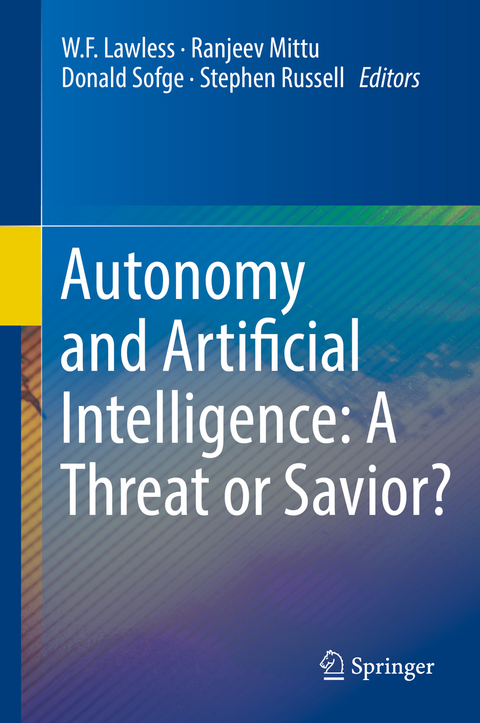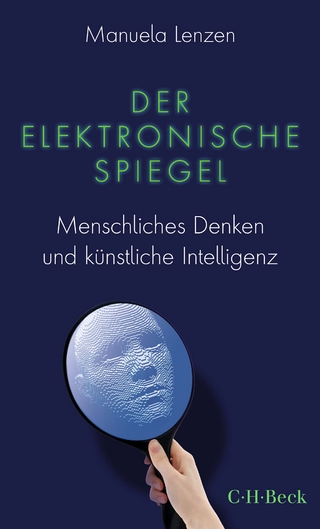
Autonomy and Artificial Intelligence: A Threat or Savior?
Springer International Publishing (Verlag)
978-3-319-59718-8 (ISBN)
This book explores how Artificial Intelligence (AI), by leading to an increase in the autonomy of machines and robots, is offering opportunities for an expanded but uncertain impact on society by humans, machines, and robots. To help readers better understand the relationships between AI, autonomy, humans and machines that will help society reduce human errors in the use of advanced technologies (e.g., airplanes, trains, cars), this edited volume presents a wide selection of the underlying theories, computational models, experimental methods, and field applications. While other literature deals with these topics individually, this book unifies the fields of autonomy and AI, framing them in the broader context of effective integration for human-autonomous machine and robotic systems.
The contributions, written byworld-class researchers and scientists, elaborate on key research topics at the heart of effective human-machine-robot-systems integration. These topics include, for example, computational support for intelligence analyses; the challenge of verifying today's and future autonomous systems; comparisons between today's machines and autism; implications of human information interaction on artificial intelligence and errors; systems that reason; the autonomy of machines, robots, buildings; and hybrid teams, where hybrid reflects arbitrary combinations of humans, machines and robots.
The contributors span the field of autonomous systems research, ranging from industry and academia to government. Given the broad diversity of the research in this book, the editors strove to thoroughly examine the challenges and trends of systems that implement and exhibit AI; the social implications of present and future systems made autonomous with AI; systems with AI seeking to develop trusted relationships among humans, machines, and robots; and the effective human systems integration that must result for trust in these new systems and their applications to increase and to be sustained.
Contributing authors: Kevin Barry, Patrick Benavidez, Chris Berka, Joseph Coyne, Boris A. Galitsky, Peter Gerken, Sri Nikhil Gupta Gourisetti, Rachel Hingst, Ayanna Howard, Mo Jamshidi, W.F. Lawless, James Llinas, Jonathan Lwowski, Ranjeev Mittu, Ira S. Moskowitz, Michael Mylrea, Anna Parnis, John J. Prevost, Adrienne Raglin, Signe A. Redfield, Paul Robinette, Galina Rogova, Stephen Russell, Alicia Ruvinsky, Mae L. Seto, Sarah Sherwood, Ciara Sibley, Donald Sofge, Douglas Summers Stay, Maja Stikic, Catherine Tessier, Alan R. Wagner.
Preface.- Introduction.- Reexamining Computational Support for Intelligence Analysis: A Functional Design for a Future Capability.- Task Allocation Using Parallelized Clustering and Auctioning Algorithms for Heterogeneous Robotic Swarms Operating on a Cloud Network .- Human Information Interaction, Artificial Intelligence, and Errors.- Verification Challenges for Autonomous Systems.- Conceptualizing Over trust in Robots: Why Do People Trust a Robot That Previously Failed?.- Research Considerations and Tools for Evaluating Human-Automation Interaction with Future Unmanned Systems.- Robot autonomy: some technical issues.- How Children with Autism and Machines Learn to Interact.- Semantic Vector Spaces for Broadening Consideration of Consequences.- On the Road to Autonomy: Evaluating and Optimizing Hybrid Team Dynamics.- Cyber-security and Optimization in Smart "Autonomous" Buildings.- Evaluations: Autonomy and Artificial Intelligence: A threat or savior?
"The volume is interesting for a wide spectrum of researchers in AI, autonomous systems, information theory, and cognitive systems (info-communication, information systems). Several thought-provoking ideas provide opportunities for further analysis, brainstorming, and research." (Bálint Molnár, Computing Reviews, October, 2018)
| Erscheinungsdatum | 25.09.2017 |
|---|---|
| Zusatzinfo | XIV, 318 p. 102 illus., 86 illus. in color. |
| Verlagsort | Cham |
| Sprache | englisch |
| Maße | 155 x 235 mm |
| Gewicht | 642 g |
| Themenwelt | Informatik ► Theorie / Studium ► Künstliche Intelligenz / Robotik |
| Technik ► Elektrotechnik / Energietechnik | |
| Schlagworte | anomalies • Artificial Intelligence • artificial intelligence (incl. robotics) • Autonomy • Computational Intelligence • Computer Science • Errors • interdependence • Robotics • Robotics and Automation • Trust • Uncertainty |
| ISBN-10 | 3-319-59718-3 / 3319597183 |
| ISBN-13 | 978-3-319-59718-8 / 9783319597188 |
| Zustand | Neuware |
| Haben Sie eine Frage zum Produkt? |
aus dem Bereich


